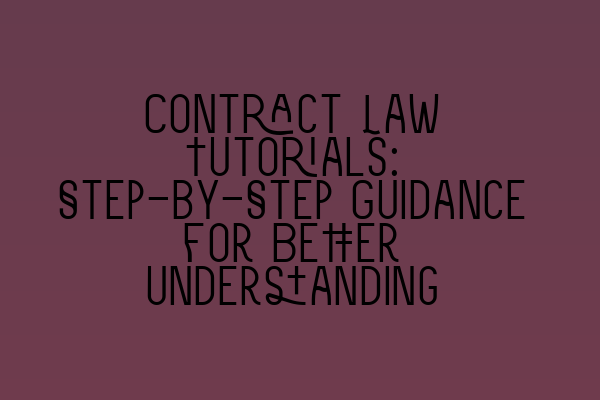Contract Law Tutorials: Step-by-Step Guidance for Better Understanding
Welcome to our comprehensive guide on contract law tutorials. Whether you are a law student, legal professional, or someone interested in understanding the intricacies of contract law, this tutorial is perfect for you. We will provide you with step-by-step guidance to help you better understand contract law concepts and principles. So let’s dive in!
1. Introduction to Contract Law
Before we delve into the complexities of contract law, let’s start with a brief introduction. Contract law refers to the body of law that governs agreements between parties. These parties can be individuals, businesses, or even governments. Contracts play a crucial role in facilitating business transactions and ensuring legal obligations are met.
It’s essential to have a solid understanding of contract law, as it affects various aspects of our lives. From employment agreements to purchasing a property, contracts are involved in every aspect of commercial and personal transactions.
To gain a comprehensive understanding of contract law, it’s crucial to acquaint yourself with the basics, such as offer and acceptance, consideration, and the intention to create legal relations. Our tutorial will cover these fundamental concepts in detail, providing you with the necessary foundation to navigate through more intricate contract law theories.
2. Essential Elements of a Contract
Contracts are legally binding agreements, and for a contract to be enforceable, certain elements must be present. Our tutorial will guide you through each element, ensuring that you grasp the importance and significance of each requirement.
The essential elements of a contract include:
- Offer and Acceptance: Understand how offers are made and accepted, forming the basis of a contract.
- Consideration: Learn about consideration, which refers to the exchange of something valuable between parties.
- Intention to Create Legal Relations: Explore the concept of intent and how it determines whether a contract is legally binding.
- Capacity: Discover the importance of parties having the legal capacity to enter into a contract.
- Legality: Understand the requirement for contracts to be formed for lawful purposes.
By understanding these key elements, you will be able to analyze and evaluate contracts effectively, ensuring their enforceability under the law.
3. Formation of a Contract
Once you have a grasp of the essential elements, it’s time to explore the process of contract formation. Our tutorial will guide you through the stages involved in creating a contract, from the initial negotiation to the final agreement.
We will cover topics such as:
- Pre-Contractual Negotiations: Understand the significance of pre-contractual negotiations, including invitations to treat and counteroffers.
- Terms of the Contract: Dive into the different types of terms, including conditions, warranties, and innominate terms.
- Vitiating Factors: Learn about misrepresentation, mistake, duress, undue influence, and illegality, which can render a contract voidable or unenforceable.
By following our step-by-step guidance, you will gain a thorough understanding of how contracts are formed and the potential pitfalls to watch out for during the process.
4. Types of Contracts
Contracts can take on various forms, each with its own unique characteristics and legal implications. Our tutorial will provide in-depth explanations of different types of contracts that you may come across:
- Express Contracts: Discover the significance of express contracts, where the terms are explicitly stated and agreed upon by all parties.
- Implied Contracts: Understand how implied contracts arise when the actions, conduct, or circumstances of the parties infer an intention to create legal relations.
- Unilateral Contracts: Learn about unilateral contracts, where one party makes an offer that can only be accepted through performance.
- Bilateral Contracts: Explore bilateral contracts, where parties mutually exchange promises and obligations.
- Executed and Executory Contracts: Differentiate between executed contracts, where all parties have fulfilled their obligations, and executory contracts, where some obligations are yet to be performed.
By familiarizing yourself with these different types of contracts, you will be equipped to identify and analyze the specific characteristics of each contract you encounter.
5. Breach and Remedies
Contracts are not immune to disputes and breaches. Understanding how breaches are addressed and the available remedies is crucial in contract law. Our tutorial will provide a step-by-step guide to analyzing breaches and determining appropriate remedies, including:
- Anticipatory Breach: Learn how to handle situations when one party indicates they will not fulfill their contractual obligations.
- Material Breach: Understand the concept of material breach and its impact on the non-breaching party’s rights.
- Monetary Damages: Explore the various types of monetary damages, including compensatory, consequential, and nominal damages.
- Equitable Remedies: Discover alternative remedies such as specific performance, injunctions, and rescission.
By gaining a comprehensive understanding of breach and remedies, you will be able to provide sound legal advice and effectively handle contract disputes.
6. Practice and Resources
Practice is essential when it comes to mastering contract law. To assist you further, we recommend checking out these related articles:
- SQE 1 Practice Exam Questions
- SQE 1 Practice Mocks FLK1 FLK2
- SQE 2 Preparation Courses
- SQE 1 Preparation Courses
- SRA SQE Exam Dates
These resources will provide you with additional practice questions, mock exams, and courses to enhance your understanding and prepare you for the SQE exams.
Conclusion
Contract law is a fundamental aspect of legal practice, and understanding its nuances is crucial for law students and legal professionals alike. This step-by-step contract law tutorial serves as a comprehensive guide, providing you with the necessary knowledge and guidance to navigate through the complexities of contract law.
We hope this tutorial has provided you with valuable insights on contract law concepts, formation, types, breaches, and remedies. By continually practicing and expanding your knowledge, you will become proficient in analyzing and navigating contract law cases successfully.
Remember, mastering contract law takes time and dedication. So start your learning journey today, and soon you will be a contract law expert!
